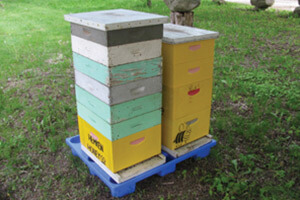
Accommodations for Beekeepers
A very good friend is going through some serious health problems, and cannot lift very much. He has been beekeeping in his back yard for many years, but has had to stop, and misses the bees. I put together a modified hive, using one deep brood box, and seven, 4-1/2” shallow supers. I had the shallow boxes squirreled away, but could not order the shallow frames any more. I had to cut down some medium end bars, and assemble the frames. I was able to assemble a fixture for the table saw to do this without severing fingers. My wife frowns on this. I also cut down plastic foundation to install in the frames. With these, he should be able to put in bees next spring.
This is one of the things I have been passing along for some of the older or more slight beekeepers, using all mediums for brood and honey, which are a lot easier to lift. If you start with a deep, it’s okay, because you rarely have to lift that first box, and can still lift each frame comfortably. All of the other hive appliances still fit, and you can extract shallow frames just as easily. I hope that readers can use this information, and maybe help out someone who is hesitant about getting into beekeeping.
PHOTO CAPTION
Adapted lighter weight supers ease lifting
Ukrainian Therapeutic Apiary House — A New Perspective
The typical structure of an apiary house includes in its design lying benches under which beehives with meshed little windows are placed which allow the beehive air unique for its composition to penetrate into the house and to be inhaled by the people staying therein. Depending on the tasks set by a beekeeper for themselves, and the possibilities, the apiary house may vary in architecture. The only aim is to improve human health using all the possibilities of a bee colony.
Speaking about the possibilities of a bee colony in terms of using it in the apiary house, it should be noted that:
– A bee colony creates the “beehive air” unique for its composition. The beehive air is saturated with phytoncides and volatile aromatic substances of nectar, bee glue, pollen, wax, Nasonov bee gland pheromones, and royal jelly evaporations. Accumulating food, a bee colony brings into the beehive nectar, bee glue, and pollen which contain aromatic substances penetrating into the beehive where they evaporate. Thus, a bee colony becomes a valuable “machine” in aromatherapy. A human being cannot gather fragrances of more than a million flowers, while a bee visits this number to produce 100 grams of honey.
– A bee colony creates acoustic vibrations.
On average, a bee colony numbers more than 20,000 – 60,000 individuals. In order to maintain the proper microclimate inside the beehive, the bees ventilate it, move their pectoral muscles to generate heat, perform informing dances to communicate a message that food has been found — all of that creates acoustic vibrations. Such vibrations have a positive as well as soothing effect on the human body and are some kind of hearing system stimulators.
– A bee colony creates a biofield. Scientists have repeatedly proved that living organisms possess a biofield. Likewise, a bee colony as a living organism has its own biofield which is similar to the one of a healthy human being.
The foregoing particularities of a bee colony are used in the existing apiary houses to ensure a therapeutic effect on the human being. Therefore, the apiary house itself has the stimulators influencing such human sense organs as hearing and smell. In this article I propose we take a broader look at a bee colony’s possibilities and begin to apply viewing beehives which will enable us to add an eyesight stimulator to the apiary house. Such a viewing beehive as shown in the photo is installed in my apiary house. (By the way, I have been engaged in beekeeping since 2010).
My viewing beehive is a prototype of a log hive (wild hive) where a bee swarm is lodged. One of the beehive walls is made of glass which enables the visitors not only to lie down or sleep in the apiary house, but also to watch a bee colony working. The viewing beehive is made of wood with an inside volume 50×35 cm; the beehive is 110 cm tall, the walls and bottom thereof are 4 cm thick. This viewing beehive enables a bee colony to develop enough strength, to rebuild a sufficient number of honeycombs and requires no special maintenance. Since the beehive volume is considerable and …


